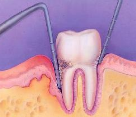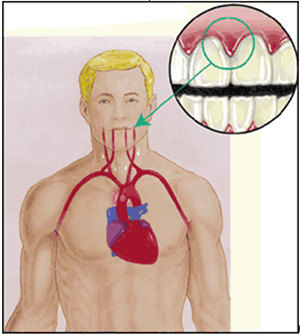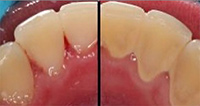Periodontal Disease

More than half of all adults ages 35 and over have the early stages of this disease. Periodontal disease is the primary cause of tooth loss after age 35. While many adults do develop some degree of periodontal disease as part of the aging process, there are some steps you can take to prevent periodontal disease. If caught in its early stages, gum disease can be reversed.
What is Periodontal disease?
Periodontal disease is cased by plaque, a colorless film of bacteria that forms on the teeth. Plaque is most harmful when these bacteria form into colonies (about 24 hours). If not removed daily, plaque mixes with sugars and starches to form acids and other by-products in the mouth. Plaque irritates the gums causing them to become tender, red and swollen. If not removed, plaque hardens to form calculus (tartar around the necks of the teeth.) Eventually, the tissue that attaches the gums to teeth is destroyed by the irritants in the plaque. The gums pull away from the teeth and small pockets fill with more plaque. Eventually, the jawbone supporting the teeth is destroyed.Other causes of Periodontal Disease:
- Physical and chemical irritants: impacted food, smoking, chewing tobacco, excessive alcohol consumption, improper use of dental floss and toothpicks.
- Oral conditions or habits: abnormal stress on the mouth tissues; badly aligned teeth, poor fitting bridges or partial dentures, defective fillings, grinding, clenching or chewing ice.
- Unbalanced diet: there is a link between nutritional deficiency and the body's ability to fight off infection. Vitamin C deficiency has been linked to gum disease.
- Pregnancy: increase hormone levels may aggravate a condition referred to as "pregnancy gingivitis"
- Diseases: diabetes, uremia, liver cirrhosis, anemia and leukemia may affect gums health.
- Certain medications: oral contraceptives, anti-epilepsy drugs, steroids and cancer therapy drugs

What are the signs?
- Gums that bleed when you brush your teeth
- Red, swollen or tender gums
- Gums that have receded or shrunken away from your teeth
- Pus between your teeth and gums when you press your gums with your finger
- Teeth that seem loose or that change position: often the front teeth tend to "fan" out
- A change in your natural bite
- A change in the way your partial dentures fit
- Bad breath or a chronic bad taste in your mouth.


